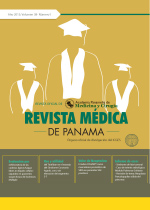Medidas Basadas En La Ejecución En Ancianos Con Historia De Caídas. Una Muestra.
Autores/as
DOI:
https://doi.org/10.37980/im.journal.rmdp.2018788Resumen
[Measures Based On The Execution In Elderly People With A History Of Falls. A Sample]
ResumenIntroducción: Las caídas constituyen uno de los llamados Grandes Síndromes Geriátricos, su elevada frecuencia a medida que envejecemos, se asocia a elevada morbi-mortalidad y discapacidad. Un abordaje diagnóstico y preventivo de esta condición, hace necesaria una Valoración Geriátrica Integral, incluyendo en ésta sistematización las llamadas Medidas Basadas en la Ejecución (MBE). El objetivo general del trabajo fue comprobar la validez de los resultados de medidas basadas en la ejecución realizadas en pacientes de 65 años en adelante. Materiales y métodos: Es un estudio descriptivo y retrospectivo que evaluó un total de 189 pacientes de 65 años en adelante, de ambos sexos, incluidos en el Programa de Caídas del Adulto Mayor (PROPRECAM), del Hospital Irma de Lourdes Tzanetatos, durante los años 2015 y 2016. Se valoraron tanto el índice de Barthel como 4 pruebas de MBE: Velocidad de la marcha, Levántate y anda, Levantarse de una silla con Brazos Cruzados y Alcance Funcional. Resultados: Los resultados se correlacionaron con la historia previa de caídas, encontrándose que el 71% presentaron prueba de velocidad de la marcha alterada, el 65.6% Prueba de Levántate y anda afectada, el 48.1% pruebas de brazos cruzados alterada y 23.8% alcance funcional deficitario. La Prueba de Velocidad de la Marcha en 4 metros fue la que más se relacionó con historia de caídas con 63.70%, seguida por Levántate y Anda con 42.85%.Conclusión: En pacientes de 65 años y más, las Medidas Basadas en la Ejecución, representan un conjunto de pruebas fácilmente aplicables, que pueden complementar y aumentar el valor predictivo para las caídas en este grupo de edad.AbstractIntroduction: Falls are one of the so-called Great Geriatric Syndromes, their high frequency as we get older, is associated with high morbidity and mortality and disability. A diagnostic and preventive approach to this condition requires an Integral Geriatric Assessment, including in this systematization the so-called Measures Based on Execution (MBE). The general objective of the work was to verify the validity of the results of measures based on performance performed on patients aged 65 and older. Material and method: It is a descriptive and retrospective study that evaluated a total of 189 patients of 65 years and older, of both sexes, included in the Program of Falls of the Elderly (PROPRECAM), of the Irma Hospital of Lourdes Tzanetatos, during the years 2015 and 2016. Both the Barthel index and 4 MBE tests were assessed: Speed of walking, Stand up and walk, Stand up from a chair with Cross Arms and Functional Reach. Results: The results were correlated with the previous history of falls, finding that 71% presented altered walking speed test, 65.6% of the Levántate test and affected, 48.1% altered crossed arms tests and 23.8% functional reach deficit. The Speed Test of the March in 4 meters was the one that was most related to history of falls with 63.70%, followed by Stand Up and Walk with 42.85%.Conclusion: In patients aged 65 years and older, the Implementation-Based Measures represent a set of easily applicable tests that can complement and increase the predictive value for the falls in this age group.
Publicado
Número
Sección
Licencia
Derechos autoriales y de reproducibilidad. La Revista Médica de Panama es un ente académico, sin fines de lucro, que forma parte de la Academia Panameña de Medicina y Cirugía. Sus publicaciones son de tipo acceso gratuito de su contenido para uso individual y académico, sin restricción. Los derechos autoriales de cada artículo son retenidos por sus autores. Al Publicar en la Revista, el autor otorga Licencia permanente, exclusiva, e irrevocable a la Sociedad para la edición del manuscrito, y otorga a la empresa editorial, Infomedic International Licencia de uso de distribución, indexación y comercial exclusiva, permanente e irrevocable de su contenido y para la generación de productos y servicios derivados del mismo. En caso que el autor obtenga la licencia CC BY, el artículo y sus derivados son de libre acceso y distribución.






